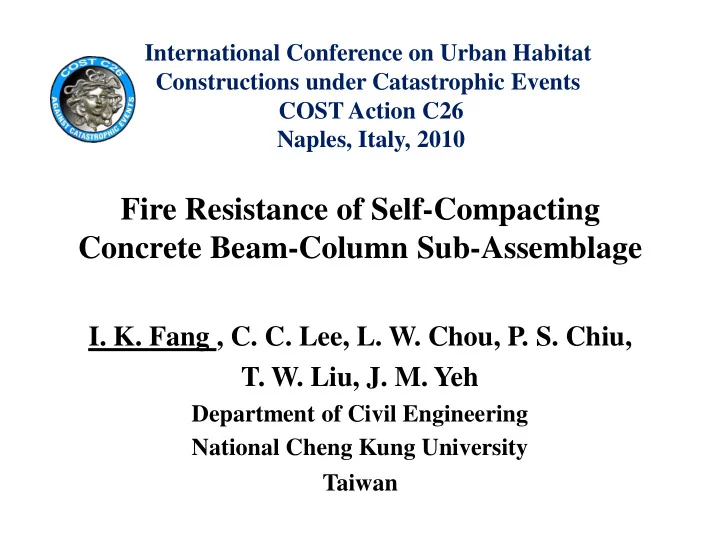

International Conference on Urban Habitat Constructions under Catastrophic Events COST Action C26 Naples, Italy, 2010 Fire Resistance of Self-Compacting Concrete Beam-Column Sub-Assemblage I. K. Fang , C. C. Lee, L. W. Chou, P. S. Chiu, T. W. Liu, J. M. Yeh Department of Civil Engineering National Cheng Kung University Taiwan
Objectives (1)Fire resistance of beam-column sub- assemblage designed based on seismic provisions (2)Possible differences between ordinary and self-compacting concrete components under fire (3)Establish the data base for future fire- performance based design
Model residential building
Deformation of model building at service load stage
Specimen installed inside the furnace before heating
Reinforcement details and locations of thermocouples
Fabrication of specimens
Beam support away from joint
Instrumentation of beam deflection measurement
Variations of furnace temperature
Temperature gradient inside beam
Variations of temperature of longitudinal reinforcement in beam
Variations of temperature of stirrup in beam
Deformed shape of beam during heating (Specimen NC5)
Deformed shape of beam during heating (Specimen SCC5)
Deformed shape of beam during heating (Specimen SCC4)
Spalling occurred along the bottom edge of beam during early stage of heating
Spalling of specimen SCC4 after heating test
Spalling of specimen SCC5 after heating test
Spalling of specimen NC5 after heating test
Spalling of column (NC5, SCC5, SCC4) NC5n NC5 SCC5 SCC4
Load procedure
Specimen SCC4 (Top of beam near joint)
Horizontal displacements of beam and column during heating (Specimen SCC5)
Rate of deflection at P2 during heating
Total beam load vs. deflection at P2 (Residual strength test)
Flexural failure near P2 (Residual strength test, Specimen NC5)
Shear failure at P1 (Residual strength test, Specimen SCC5)
Conclusions 1) The specimens, designed according to the ACI 318 seismic provisions, behaved satisfactorily under ISO834 standard fire exposure for three hours. 2) Most of the concrete spalling occurred along the bottom edge of beams and corner of lower column during the early twenty five minutes of heating. Relatively more spalling was observed at bottom of beam in normal concrete specimen NC5.
Conclusions 3) The maximum temperatures recorded at several locations in longitudinal reinforcements of beam and column reached 580 ℃ , which exceeds the limit 550 ℃ at single point specified in Taiwanese Standard CNS 12514.
Conclusions 4) Relatively more vertical displacements in beam occurred in the first thirty minutes of heating, and then the increase of vertical displacement decreased during the thirty to sixty minutes due to the low temperature rise in beam.
Conclusions 5) The normal and self-compacting concrete specimens behaved quite closely in their load- displacement relationships at load point in residual strength test.
Conclusions 6) Two specimens failed in ductile flexural mode and one specimen failed in unfavorable diagonal shear after exhibiting significant yield behavior in beams. The decrease of shear strength in beam cross section has to be checked carefully after fire hazard.
Recommend
More recommend